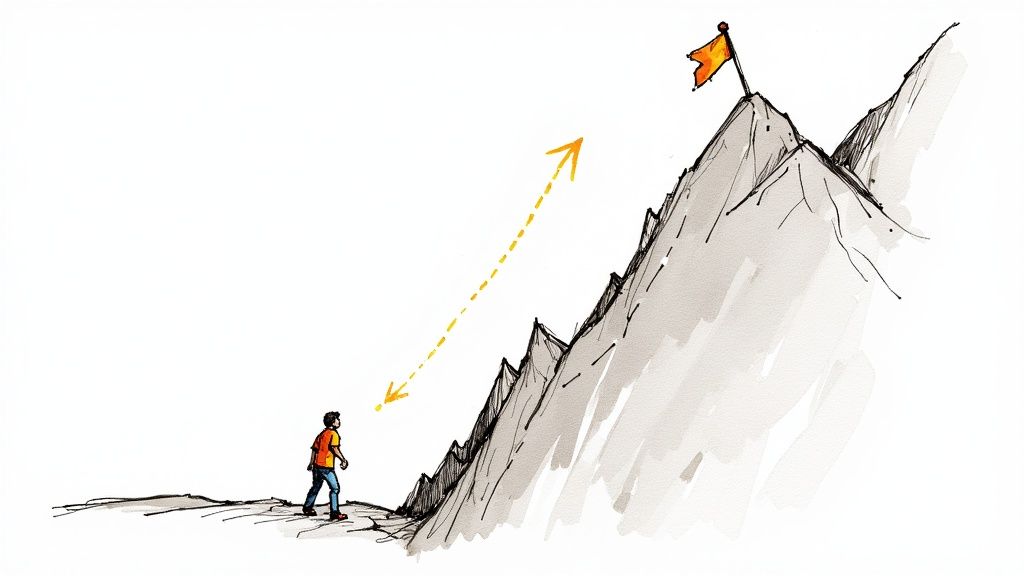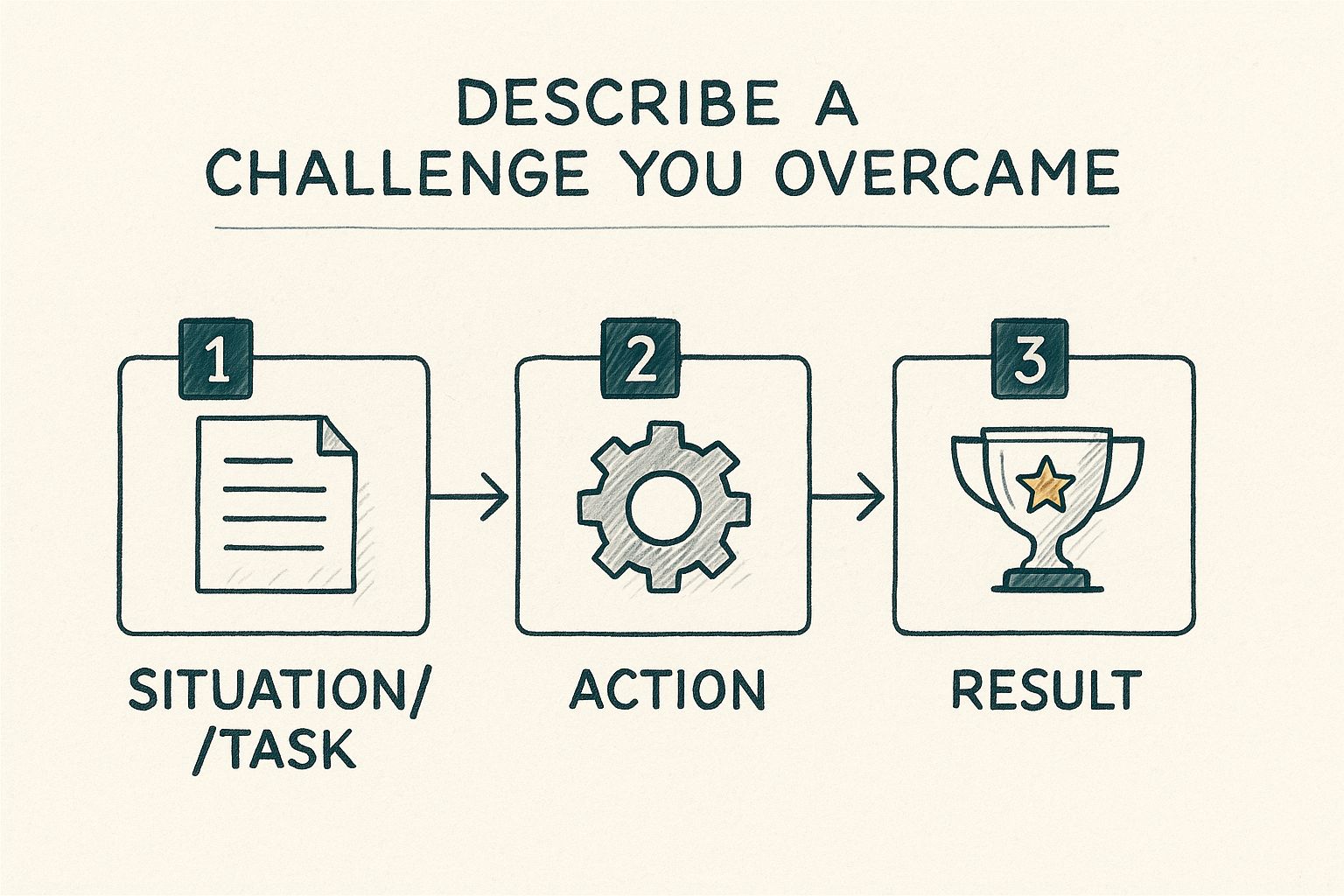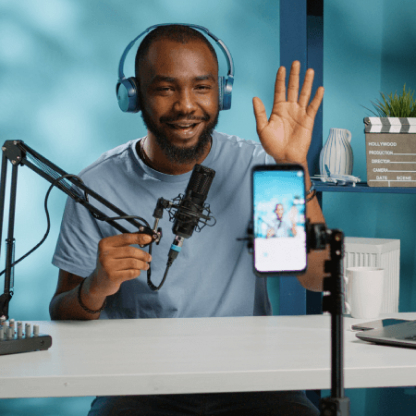Let's be honest. The traditional hiring process is a time-sink. You're drowning in a sea of PDFs, hoping to find a unicorn, but mostly just getting paper cuts. Then come the scheduling nightmares, the no-shows, and the "tell me about yourself" monologues that go absolutely nowhere.
We’ve been there. We’ve mortgaged the metaphorical ping-pong table to find great talent, and we learned that the initial screening is where most teams get it wrong. It’s not about finding the perfect resume; it’s about identifying the right potential, fast.
On-demand video interviews are the fix, but only if you ask the right questions. Forget the generic fluff that invites rehearsed answers. This guide is built for hiring managers who need to see genuine capability, not just a well-written bio.
We’re going to break down the 8 essential on demand video interview questions that separate the contenders from the pretenders. These aren't just questions; they are strategic tools designed to reveal character, competence, and culture fit before you ever have to book a single meeting. This is how you reclaim your calendar and start seeing real potential. Let's get to it.
1. Tell Me About Yourself
Let's start with the classic opener, the "Tell me about yourself" question. It seems simple, almost a throwaway, but in the world of asynchronous interviews, it’s a high-stakes moment. This isn't just an icebreaker; it’s the candidate's opening pitch, setting the entire tone without you in the room to guide them. It’s your first real data point on their communication skills, professionalism, and ability to think on their feet.

Tech and finance giants don't use this question by accident. Companies like Amazon, Unilever, and Goldman Sachs consistently lead with it in their on-demand video interviews. They understand that a candidate's answer reveals more than just their resume; it shows how they structure a narrative, prioritize information, and connect their past experiences to the future they want with your company.
Strategic Breakdown & Scoring Tips
When evaluating responses to this crucial question, don’t just listen for keywords. Look for structure and relevance. A great answer is a concise, compelling story, not a rambling life history.
- The Present-Past-Future Formula: The best candidates follow this structure. They start with their current role (Present), connect it to relevant past experiences (Past), and pivot to why they are excited about this specific opportunity (Future). It's clean, logical, and shows they prepared.
- Concise and Relevant: Did they keep it under two minutes? A rambling answer is a red flag for poor communication. More importantly, did they connect their story directly to the role? A generic pitch is a sign they’re just spamming applications.
- Enthusiasm is Key: The answer should end on a high note, expressing genuine interest in the position and your company. A flat, uninspired closing suggests a lack of real motivation. This is a key differentiator and something you'll want to review when mastering your on-demand video interview process.
2. Why Are You Interested in This Position/Company?
Next up is the classic motivation-checker: "Why are you interested in this position?" This question is your litmus test for genuine interest versus a spray-and-pray application strategy. In an on-demand video interview, the answer separates the candidates who did their homework from those just looking for any job. It’s your window into their research skills, cultural alignment, and long-term intentions.

It’s no surprise that mission-driven companies rely heavily on this question. Tesla uses it to weed out anyone who isn’t fanatical about their mission to accelerate the world's transition to sustainable energy. Similarly, Salesforce and Google use it to ensure candidates' values align with their deeply ingrained corporate cultures. A generic answer is a fast track to the "no" pile because it shows a fundamental lack of specific, directed interest.
Strategic Breakdown & Scoring Tips
When scoring this response, you're looking for evidence of thoughtful research and authentic connection. A candidate who simply recites your "About Us" page isn't cutting it. You need specifics.
- Evidence of Deep Research: A top-tier candidate will go beyond the homepage. They’ll reference a specific company initiative, a recent product launch, a blog post from your CEO, or even a line from your quarterly report. This proves they’ve invested time and are genuinely intrigued by your company’s direction.
- Connects Personal Goals to Company Mission: Great answers build a bridge. The candidate should clearly articulate how their personal career aspirations connect directly to the company's opportunities and the specific responsibilities of the role. It’s about mutual benefit, not just what the company can do for them.
- Avoids Generic Flattery: Watch out for empty praise like "I've always admired your great reputation." This is a major red flag. A strong response is packed with concrete details, showing why they admire the company and how they see themselves contributing to its continued success.
3. Describe a Challenge You Overcame
This is where you separate the talkers from the doers. Asking a candidate to describe a challenge they overcame is a classic behavioral question that’s supercharged in an on-demand video format. It’s not just about what they did; it’s about how they construct a story under pressure. You’re looking for resilience, problem-solving skills, and a growth mindset, all packaged in a coherent narrative.
Companies like Microsoft and JPMorgan Chase love this question because it cuts straight to the core of a candidate’s ability to handle adversity. Microsoft uses it to find individuals with a growth mindset, while financial institutions use it to gauge how someone performs in a crisis. A candidate's answer reveals their capacity to learn from mistakes and turn a difficult situation into a valuable experience.
Strategic Breakdown & Scoring Tips
A great response isn't just about a heroic victory; it's about the process and the learning. Look for a structured, reflective answer that shows self-awareness and tangible impact. A story without a clear result is just a complaint.
- Follow the STAR Method: The gold standard for behavioral questions. A top-tier candidate will clearly outline the Situation, their Task, the Actions they took, and the Result. This structure shows they can communicate complex events clearly and logically.
- Focus on Action and Results: Pay close attention to the "Action" part of their story. Did they take ownership, or do they describe a team effort where their role is unclear? The best answers are specific about their personal contribution and quantify the results whenever possible. "Increased efficiency by 15%" is infinitely better than "made things better."
- Show What You Learned: A strong answer always concludes with the key takeaway or lesson learned. This demonstrates self-awareness and a commitment to continuous improvement, proving they don't just solve problems but grow from them. Tackling workplace issues with grace is a skill, and this question reveals who has it.
The following visual breaks down the STAR method, which is the ideal framework for structuring a compelling answer to this question.

This process flow highlights how a structured narrative moves from context to a tangible, positive outcome, which is precisely what you want to see in a candidate's response.
4. What Are Your Greatest Strengths?
This question seems like a softball, an easy opportunity for a candidate to brag. But in an on-demand video interview, it’s a critical test of self-awareness and relevance. You're not just asking "What are you good at?"; you're asking, "Do you understand what we need, and can you prove you have it?" Their answer is a direct window into how they perceive their own value and whether they've done their homework on your company.
It’s a staple for a reason. Consulting firms like Deloitte use it to see if a candidate can articulate their analytical and client-facing skills concisely. Tech giants like Meta use it to find a perfect match between a candidate's abilities and a specific team's needs. This question helps you quickly filter for candidates who not only possess the right skills but can also articulate their value proposition effectively, a key skill in any role.
Strategic Breakdown & Scoring Tips
A strong answer here is less about the strength itself and more about the evidence provided. Vague, unsupported claims are a major red flag. You're looking for a candidate who can connect their skills directly to the job description with concrete proof.
- The Rule of Three (with Evidence): The best responses focus on two or three core strengths that are highly relevant to the role. For each strength, they should provide a specific, brief example or metric that proves it. "I'm a great communicator" is weak; "I'm a great communicator who unified three cross-functional teams to launch our new platform 15% ahead of schedule" is strong.
- Job Description Alignment: A top-tier candidate will have dissected your job description and tailored their answer accordingly. Did they pick strengths that directly address the key responsibilities and challenges of the position? This shows genuine interest and strategic thinking, not just a canned response.
- Avoid Clichés: Watch out for generic answers like "hard-working" or "perfectionist" without context. These are often signs of a candidate who hasn't prepared. A great candidate will choose more specific, impactful strengths like "data-driven decision making" or "mentoring junior developers" and back them up with real results.
5. Where Do You See Yourself in 5 Years?
This question is the crystal ball of the interview world. It feels a bit clichéd, but in an on-demand video format, it’s a powerhouse for gauging a candidate's ambition, realism, and long-term fit. You're not just hiring for a role; you're investing in a person's future. Their answer tells you if that future includes you.
It's a staple for a reason. Companies like IBM and Accenture use it to assess leadership pipeline potential and see if a candidate’s career trajectory aligns with their structured growth paths. General Electric leans on this question for succession planning, identifying who has the foresight and ambition to grow with them. They’re looking for someone who sees a future with their organization, not just a stepping-stone job.
Strategic Breakdown & Scoring Tips
When evaluating this forward-looking question, you're screening for alignment and ambition, not a legally binding contract. A great answer is a thoughtful projection that connects their personal growth to your company's opportunities.
- Focus on Growth, Not Titles: The best answers center on skill development and contributions. Look for candidates who say, “I hope to have become an expert in [relevant skill] and be leading projects that…” instead of, “I want to be a Senior Vice President.” The former shows a commitment to craft; the latter can sound entitled.
- Company Alignment is Crucial: Does their five-year plan even remotely match the growth opportunities you offer? A candidate who clearly researched potential career paths at your company and ties their goals to them gets top marks. It shows they aren't just looking for any job, they're looking for this job.
- Demonstrate Flexibility: A rigid, overly specific plan can be a red flag. The ideal candidate expresses a clear direction but also acknowledges that they are adaptable and open to opportunities as they arise within the company. This blend of ambition and flexibility is what you want in a dynamic work environment.
6. Why Are You Leaving Your Current Job?
This question is the professional equivalent of walking a tightrope. It seems straightforward, but one wrong step can send a candidate’s application plummeting. In an on-demand video interview, this question is a powerful tool for gauging a candidate's professionalism, emotional intelligence, and discretion without you there to read the room. It’s not about getting office gossip; it’s about understanding their motivations and how they handle sensitive narratives.
Global professional services firms and tech leaders lean heavily on this question. Companies like Ernst & Young, PwC, and Apple use it to see beyond the resume. They are testing for diplomacy, a forward-looking attitude, and the ability to frame a career transition positively. A candidate who complains about their boss or company is an immediate red flag, signaling potential future issues with teamwork and company loyalty.
Strategic Breakdown & Scoring Tips
When evaluating a candidate’s answer, you’re looking for a delicate balance of honesty and positivity. Their response reveals their core drivers and how they navigate professional relationships.
- The Positive Pivot: A strong answer never badmouths a current or former employer. Instead, it focuses on the "pull" of the new opportunity rather than the "push" from the old one. Look for candidates who frame their departure in terms of seeking new challenges, growth opportunities, or a better alignment with their long-term career goals.
- Future-Focused Language: Listen for phrases like "I'm looking to grow my skills in…" or "I'm excited by the opportunity to contribute to…" This shows they are running toward something, not away from something. This forward momentum is a key indicator of a motivated and ambitious candidate.
- Connect to Your Role: The best answers directly link their reasons for leaving to what your specific role and company offer. A candidate who says, "I'm seeking a more collaborative environment, which is why your team-based project structure is so appealing," demonstrates they’ve done their research and are making a deliberate, informed career move.
7. Give an Example of Working in a Team
Next up is the ultimate culture-fit litmus test: “Give an example of working in a team.” In an on-demand video interview, this question isn't just about whether they play nice with others. It’s a direct window into their collaboration style, problem-solving approach, and how they define their own contribution within a group dynamic, all without you there to probe for details.
This question is a staple for a reason. Tech giants like Spotify use it to see if candidates can thrive in their agile, squad-based structure. Amazon famously uses teamwork questions to test their "Earn Trust" leadership principle, while Netflix looks for signs that a candidate will elevate their "Dream Team" culture. Their answers reveal whether they see a team as a support system, a battleground for ideas, or a vehicle for shared success.
Strategic Breakdown & Scoring Tips
When reviewing answers, you're not just looking for a happy story about a successful project. You’re dissecting their role, their attitude, and the outcome they focus on. A candidate who only talks about their own success is a major red flag.
- Clarity of Contribution: The best answers clearly articulate the candidate's specific role and actions. They use "I" when describing their own tasks and "we" when discussing team goals and achievements. Vagueness here often hides a lack of meaningful involvement.
- Conflict Resolution and Adaptability: A great response doesn't shy away from challenges. Did they mention a disagreement or a moment where the team had to pivot? How they navigated different perspectives or conflicts is far more revealing than a story where everything went perfectly.
- Focus on Shared Outcomes: Look for candidates who frame the final result as a team victory. Their pride should be in what the team accomplished together, not just their individual heroics. This is a critical indicator of a collaborative mindset and a key component of effective on-demand video interview questions.
8. Do You Have Any Questions for Us?
Finally, the classic closing question: "Do you have any questions for us?" In an on-demand video interview, this isn't a mere formality; it's the candidate's final opportunity to leave a lasting impression. It’s a test of their preparation, curiosity, and genuine interest. A candidate who has no questions might as well have a flashing neon sign that says, "I just want any job."
This question is a favorite across industries for a reason. Top-tier organizations like McKinsey expect candidates to ask insightful questions about business challenges or consulting methodologies. At Google, thoughtful queries about team dynamics or project roadmaps demonstrate the proactive mindset they covet. A blank stare is a deal-breaker.
Strategic Breakdown & Scoring Tips
When a candidate reaches this final question, you're not just checking a box. You’re evaluating their level of engagement and strategic thinking. Their questions reveal how deeply they’ve considered the role beyond the job description.
- Depth Over Fluff: The best candidates ask questions that show they've done their homework. They’ll inquire about team structure, performance metrics for the first six months, or the company's biggest upcoming challenges. Questions about salary or vacation time are a major red flag at this stage.
- Strategic and Role-Focused: Did their questions relate directly to the position or the team they'd be joining? A great question is, "What does success look like in this role a year from now?" A poor one is, "What does your company do?" One shows ambition; the other, a lack of basic preparation.
- Curiosity and Enthusiasm: A candidate with a few well-prepared questions signals genuine interest and intellectual curiosity. It demonstrates they see this as a potential career, not just another application to fire off. This moment is a key part of the modern virtual interview process; for more insights, see these powerful virtual interview tips.
Key Comparison of 8 On-Demand Interview Questions
| Question Title | Implementation Complexity 🔄 | Resource Requirements ⚡ | Expected Outcomes 📊 | Ideal Use Cases 💡 | Key Advantages ⭐ |
|---|---|---|---|---|---|
| Tell Me About Yourself | Low – open-ended, easy to prepare | Minimal – just candidate time to prep | Insight into communication, self-awareness, first impression | Universal for all roles and industries | Flexibility in responses; sets interview tone |
| Why Are You Interested in This Position/Company? | Medium – requires company research | Moderate – 30-60 min of research | Assesses motivation, cultural fit, company knowledge | Mid- to senior-level roles; cultural fit emphasis | Reveals genuine interest; predicts retention |
| Describe a Challenge You Overcame | Medium to High – needs STAR structure | Moderate – preparation for specific examples | Demonstrates problem-solving, resilience, growth | Behavioral interviews; roles requiring adaptability | Concrete evidence of skills under pressure |
| What Are Your Greatest Strengths? | Low to Medium – self-reflection needed | Minimal to moderate – candidate prep | Evaluates self-awareness and value proposition | Any role requiring self-assessment and confidence | Highlights differentiators; opportunity to stand out |
| Where Do You See Yourself in 5 Years? | Medium – forward-looking, requires planning | Minimal – reflective preparation | Measures ambition, goal-setting, growth alignment | Positions with career progression paths | Shows planning ability; indicates potential |
| Why Are You Leaving Your Current Job? | Medium – sensitive topic, diplomatic framing | Minimal to moderate prep | Reveals motivations, professionalism, red flags | Any role where career transitions are relevant | Assesses communication on difficult topics |
| Give an Example of Working in a Team | Medium – behavioral, requires example prep | Moderate – choice and prep of team example | Assesses collaboration, communication, conflict resolution | Roles emphasizing teamwork and interpersonal skills | Shows adaptability and leadership potential |
| Do You Have Any Questions for Us? | Low – end of interview, candidate-driven | Minimal – prepare thoughtful questions | Measures engagement, preparation, strategic thinking | All interview types; especially final stages | Demonstrates genuine interest; leaves good impression |
The Takeaway: Your Interview is a Product, Not a Process.
Alright, let's land this plane. We've walked through the classic hits of interview questions, from "Tell Me About Yourself" to the dreaded "Where do you see yourself in five years?" But if you walk away thinking this was just a list of questions to copy and paste, you’ve missed the point entirely. Treating your hiring process like a bureaucratic checklist is how you end up with candidates who are great at interviewing but mediocre at their jobs.
Your interview is a product. It’s the first real, tangible experience a candidate has with your company's culture and brainpower. Is it thoughtful, challenging, and respectful of their time? Or is it a generic, one-size-fits-all administrative hurdle? The quality of the questions you ask directly reflects the quality of the talent you’ll attract. If your questions are boring, you’ll attract boring people. It’s that simple.
Stop Filtering, Start Previewing
The goal of using these on demand video interview questions isn't just to filter people out; it's to get a genuine preview of who they are and how they think. It's your first, and often best, chance to see beyond the polished buzzwords on their LinkedIn profile. Are they articulate? Can they think on their feet? Do they show genuine enthusiasm or just practiced poise? You can’t get that from a PDF resume.
The real magic happens when you stop seeing asynchronous interviews as a simple screening tool and start viewing them as a strategic asset. By front-loading your process with thoughtful, well-designed questions, you achieve two critical things:
- You reclaim your time: Your team stops wasting precious hours on first-round calls with candidates who were never a fit to begin with.
- You engage top talent early: You give the best candidates a platform to shine and demonstrate their value, making them feel seen and valued from the first interaction.
This isn't about replacing the human element; it's about elevating it. You’re automating the repetitive, low-value parts of hiring so you can invest your energy where it actually matters: building relationships with your top contenders. You're not just filling a seat. You're making a multi-thousand-dollar investment in a person you hope will drive your company forward. Start acting like it.
By refining your set of on demand video interview questions, you move from a reactive, resume-chasing model to a proactive, talent-engaging one. You build a machine that surfaces the right people faster, giving you a massive competitive edge in a tight talent market. Stop processing applications and start building your team.
Tired of the endless cycle of scheduling, screening, and chasing candidates? Async Interview was built to kill the administrative drudgery of hiring by automating your top-of-funnel with smart, on demand video interviews. Start making better, faster, and more human connections by trying it for free at Async Interview.




